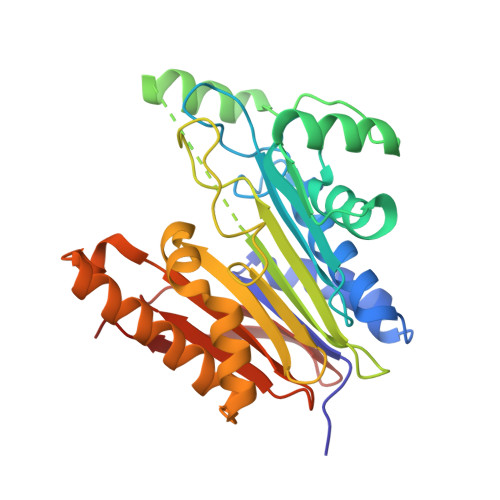Crystal structure of a mutant glycosylasparaginase shedding light on aspartylglycosaminuria-causing mechanism as well as on hydrolysis of non-chitobiose substrate.
Pande, S., Lakshminarasimhan, D., Guo, H.C.(2017) Mol Genet Metab 121: 150-156
- PubMed: 28457719
- DOI: https://doi.org/10.1016/j.ymgme.2017.04.008
- Primary Citation of Related Structures:
5V2I - PubMed Abstract:
Glycosylasparaginase (GA) is an amidase that cleaves Asn-linked glycoproteins in lysosomes. Deficiency of this enzyme causes accumulation of glycoasparagines in lysosomes of cells, resulting in a genetic condition called aspartylglycosaminuria (AGU). To better understand the mechanism of a disease-causing mutation with a single residue change from a glycine to an aspartic acid, we generated a model mutant enzyme at the corresponding position (named G172D mutant). Here we report a 1.8Å resolution crystal structure of mature G172D mutant and analyzed the reason behind its low hydrolase activity. Comparison of mature G172D and wildtype GA models reveals that the presence of Asp 172 near the catalytic site affects substrate catabolism in mature G172D, making it less efficient in substrate processing. Also recent studies suggest that GA is capable of processing substrates that lack a chitobiose (Glycan, N-acetylchiobios, NAcGlc) moiety, by its exo-hydrolase activity. The mechanism for this type of catalysis is not yet clear. l-Aspartic acid β-hydroxamate (β-AHA) is a non-chitobiose substrate that is known to interact with GA. To study the underlying mechanism of non-chitobiose substrate processing, we built a GA-β-AHA complex structure by comparing to a previously published G172D mutant precursor in complex with a β-AHA molecule. A hydrolysis mechanism of β-AHA by GA is proposed based on this complex model.
- Department of Biological Sciences, University of Massachusetts Lowell, 1 University Avenue, Lowell, MA 01854, USA.
Organizational Affiliation:
















